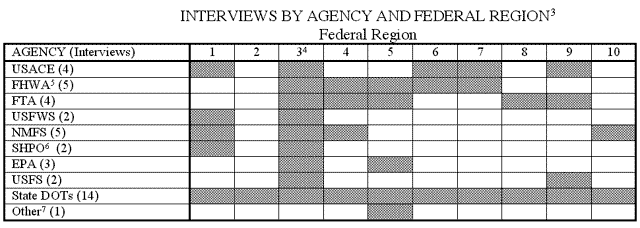APPENDIX C
Agency Stakeholder Interviews — Summary and Conclusions
This is an abstract of a report on the results of interviews with representatives from transportation, environmental resource, environmental regulatory and historic preservation agencies: Environmental Streamlining Dispute Resolution Project, Alternative Dispute Resolution System Design — Stakeholder Interview Summary, W. Steve Lee and Dale Keyes, U.S. Institute for Environmental Conflict Resolution, for the U.S. Department of Transportation, Federal Highway Administration, September 2000.
Purpose and Process
An important early step in designing an ADR system is to conduct an assessment of how disputes are currently managed or resolved and whether there is a need for new or improved dispute resolution processes. Stakeholders1 are the best source of this information. The assessment results set the context for the design of an ADR system.
The USIECR sought from the FHWA and the other signatory agencies to the Environmental Streamlining National Memorandum of Understanding (MOU) recommendations of individuals from Federal and some key state agencies to consult during the assessment. In addition to the USDOT (FHWA and FTA), the signatory agencies to the MOU include the:
- U.S. Department of the Interior (Fish and Wildlife Service — USFWS and National Park Service — NPS)
- U.S. Department of Agriculture (U.S. Forest Service — USFS)
- U.S. Department of Commerce (National Marine Fisheries Service — NMFS)
- U.S. Army Corps of Engineers (USACE)
- U.S. Environmental Protection Agency (EPA), and
- Advisory Council on Historic Preservation
The FHWA and other members of the Environmental Streamlining Interagency Work Group2 provided the names of the people with experience in transportation planning and NEPA. These included representatives from each of the Federal agencies listed above, state departments of transportation (state DOTs), and state historic preservation offices (SHPOs). As the table below shows, a total of 34 interviews were conducted with individuals with at least one interview in each of ten Federal regions. In addition, eight consultations were conducted with headquarters staff of environmental resource and regulatory agencies in Washington, DC (see footnote 4).

The interviews were conducted by telephone during May and June 2000 by W. Steve Lee. Each interview lasted an average of 45 minutes.
The purpose of the interviews was to capture individual experiences and observations related to the NEPA review process as it is applied to transportation projects. The interview subjects were not provided any questions in advance of the interview. It is important to note that the interview subjects spoke on the understanding that the comments would not be attributed to a specific individual. However, many of the statements below do mention specific agencies. In some instances the interviews included more than one representative from the agency.
The interviews collectively constitute a survey of stakeholders. However, no attempt was made to assure statistical representativeness whereby results could be evaluated quantitatively by geographical area or agency. Instead, common experiences and general themes were sought that could be used to inform the design of an ADR system.
Interview Topics
The following topics were used as an organizing structure for the interviews:
- Factors that Slow the Project Development and NEPA Review Processes
- Conflicts that Lead to Impasse
- How Conflicts are Resolved Currently
- Experience with Facilitation/Mediation and Training
- Examples of Successful Conflict Management and Resolution
- Suggested Roles for the FHWA
Conclusions
Following are general conclusions drawn from the interviews:
- Experience with transportation development and environmental review varies substantially among states and among agencies. A "one size fits all" approach to environmental streamlining and, more specifically, to the design of an ADR system, is not appropriate.
- Collaborative planning and decision-making in the early stages of transportation project development should work seamlessly with conflict resolution processes implemented at the NEPA review stage. Taken together, they should be viewed as conflict management.
- Collaborative activities during the NEPA review process are also useful in reducing the frequency and intensity of conflict.
- Financial constraints continue to be a major limitation to the ability of resource and regulatory agencies to engage in collaborative processes. Funding of resource and regulatory agency positions by state DOTs as allowed under TEA-21 appears to overcome this impediment where it has been used.
- Reaching agreements among agencies on points of concurrence, timelines for sign-offs, and the written records of concurrence will set the stage for faster reviews and better management of disputes when they arise.
- Most current dispute resolution systems employ elevation procedures. However, the nature of the elevation varies significantly among agencies and by applicable regulation.
- Model environmental streamlining structures address conflict resolution by identifying specific points of concurrence in the environmental review process, and designing processes to be applied at each of these points.
|

